The Fast Life and Scandalous Downfall of an Olympic Champion
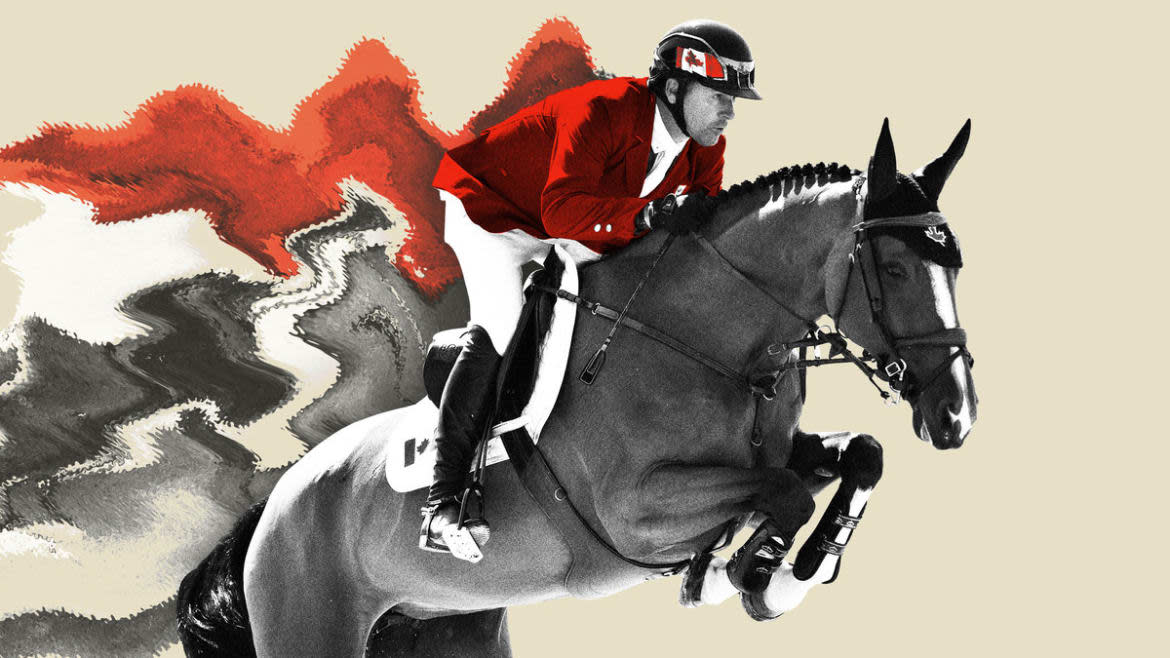
- Oops!Something went wrong.Please try again later.
If you believe Eric Lamaze, which fewer and fewer people do, the Olympic champion was given two hours to live in 2020 before he absconded from the hospital and went home to recover on his own. His vitals were failing, he says; the bleeding ulcer in his stomach was the largest the doctors had ever seen. As he left, his story goes, the needles were still in his arm.
“I told my cleaning lady, ‘Put the TV as loud as you can and throw a bucket of water on me every 30 minutes,’” Lamaze, one of the greatest show jumpers in history, tells The Daily Beast.
Morning came, and light poured in. “For a second, the sun—whoom—went in front of me, and I swear to God, it was like an angel just flew by. My color changed,” he says, “I could breathe.” Three years later, he’s still alive.
This is not a story likely to persuade skeptics, at a time when Lamaze is desperate for new allies. Six years ago, Lamaze announced he had been diagnosed with brain cancer—specifically, glioblastoma, an aggressive tumor with a five-year survival rate of about 6.9 percent. Most patients don’t survive two years.
“Not operable,” Lamaze says of his diagnosis.
At the time, Lamaze was facing a legal battle over horses he had sold, and since then, at least four buyers or business partners have claimed he ripped them off, too. The first lawsuit, which centered on three disputed sales, was delayed in light of his condition, but this summer, the trial date was finally approaching. Then, Lamaze’s lawyer submitted filings declaring that the cancer had “spread to his throat.” (Glioblastoma tumors rarely spread to other parts of the body, a neuro-oncologist told The Daily Beast.)
The attorney also sent a medical report asserting that Lamaze was expected to undergo a “high-risk” craniotomy in August that likely would render him unable to speak, “quite possibly on a permanent basis.” (In more than four hours of interviews with The Daily Beast this month, he sounded energized and lucid.)

A photo supplied by Eric Lamaze showing him in a hospital bed.
Opposing counsel was immediately suspicious of the filings, which included a letter supposedly from Lamaze’s neurosurgeon in the Netherlands. The address appeared wrong, the doctor’s name was spelled differently on his website, and the document was written in Dutch, which the surgeon does not speak.
A private detective hired by the plaintiffs quickly confirmed that the document was a forgery. If Lamaze did have brain cancer, there was no evidence to prove it. Even his lawyer, a close friend of three decades, asked the court to be removed as his counsel, saying he could no longer trust his client. (A judge has yet to rule on the request.)
“The Dutch doctor never existed,” Lamaze now says. “I never had a Dutch doctor.” He claims he did not see the letter before it was submitted to the court and blames a member of his staff for doing some “funny things.” The craniotomy, he adds, also never happened.
Well, then, who is his oncologist? In an interview last week, Lamaze teased a possible Zoom reveal with the real doctor, though that has yet to happen. He says he is concealing the physician’s identity in part because in Belgium, where Lamaze says he lives, foreigners aren’t allowed to receive long-term care if they could instead be treated overseas. (This, it turns out, is not actually true.) Lamaze also emphasizes, fairly, that he has yet to fully defend himself against the forgery allegations in court.
The insular equestrian community is now consumed by intrigue. Some are disdainful; most seem sad. Lamaze, 55, had endured a bleak childhood to become a hero of their sport. He was booted from two Olympic Games over positive drug tests, only to rally back to win gold. He sold horses to the most prominent athletes, including Michael Bloomberg’s daughter and high-level pros. And now? In his body or his brain, something does not seem right.
“My observation of Eric was, he pretty much didn’t listen to anybody. He just went by the beat of his own drum. And I’m talking about him like he’s dead,” says Dianne Grod, an equestrian trainer who met Lamaze more than two decades ago. “He kind of is, in our world.”
Riding Solo
In stereotype, show jumping is a sport for the rich and pampered, but Lamaze had a tough start. His father was absent, and his home life was precarious. His mother, Danièle, dropped out of the Canadian air force after she got pregnant, spent time working on a commercial boat, then bartended at a strip club.
“He basically raised himself,” his ex-wife Megan Johnstone, whom he married in 2001, tells The Daily Beast.
When Lamaze was young, Danièle was arrested for stealing credit cards. “I went to see her in jail when I was like 6 years old,” he says.
Lamaze operated with limited parental oversight, and he spent years living with his grandmother. As a preteen, he says, he would cut class for more enticing adventures. “We were going skiing, like, full of fucking cocaine.” He dropped out of school in the eighth grade, he says.
Lamaze found an outlet in sports. Early in his teenage years, his mother asked him to choose between his two principal hobbies, tennis and horseback riding, she said in a Facebook message to The Daily Beast. Lamaze chose to ride.
Initially, he had been terrified in the ring. He grew up without pets and felt unnatural near the animals while standing on the ground. Somehow, in the saddle, his fear melted.
He was also attracted to the sport’s close ties to wealth. Lamaze recounts seeing Mercedes-Benzes and BMWs parked in front of the stables: “I was like, ‘Woah, what kind of world is this?’”
The equestrian industry gave Lamaze direction and, soon, a lucrative career. But a permanent rift had formed in his personal life. “I never forgave her for what she put me through,” he says, referring to his mother. As he aged, he reflected more on his childhood and “realized that it was crazy.”
Danièle Lamaze says she is still proud of her son and that she tried her best to provide him with opportunities. On her Facebook page, she refers to him as “our champion.”
Overnight Millionaire
Cathy Inch, an equestrian coach in Ontario, first met Lamaze in the late 1980s. French was his first language, and he still barely spoke English. Lamaze, Inch recalls, was enamored by the area’s “big, loud bars,” and he adapted to his new milieu. “He’s highly intelligent,” she says, and had no trouble blending “amongst the rich and famous.”
Lamaze developed a profitable business buying and selling show jumpers. His first big score came when he acquired an $800 horse at the racetrack; he says he found a buyer who paid him $150,000 for it. (The Daily Beast was unable to confirm this independently.) This kind of deal-making embodied his approach to business: There’s “nothing illegal” about fat margins, he says. “If somebody’s willing to pay it, who cares?”
By his twenties, Lamaze says, he was generating millions of dollars in annual sales. His success surprised him, and he figured he had peaked; he had no expectations of becoming a top-flight rider: “I just thought I would buy and sell horses and make enough money to live.”
Meanwhile, his ascent continued. In 1996, Lamaze earned a spot on the Canadian Olympic team. But the blissful moment proved fleeting. Soon after qualifying, he tested positive for cocaine.
“I had no idea there was drug testing. I was so naive,” he says. Lamaze claims he used drugs just once during this period. Some old friends had visited Toronto, and after a night shooting pool and blowing off steam, one of them “cracked up a little bit of powder.” He received a four-year suspension and lost his spot on the team.
The punishment was later reduced to seven months, when an arbitrator “decided that his personal circumstances—growing up with a mother who dealt drugs most prominent among them—were sufficient to have his ban lifted in time to participate at the 1998 World Equestrian Games,” according to his Olympic biography.
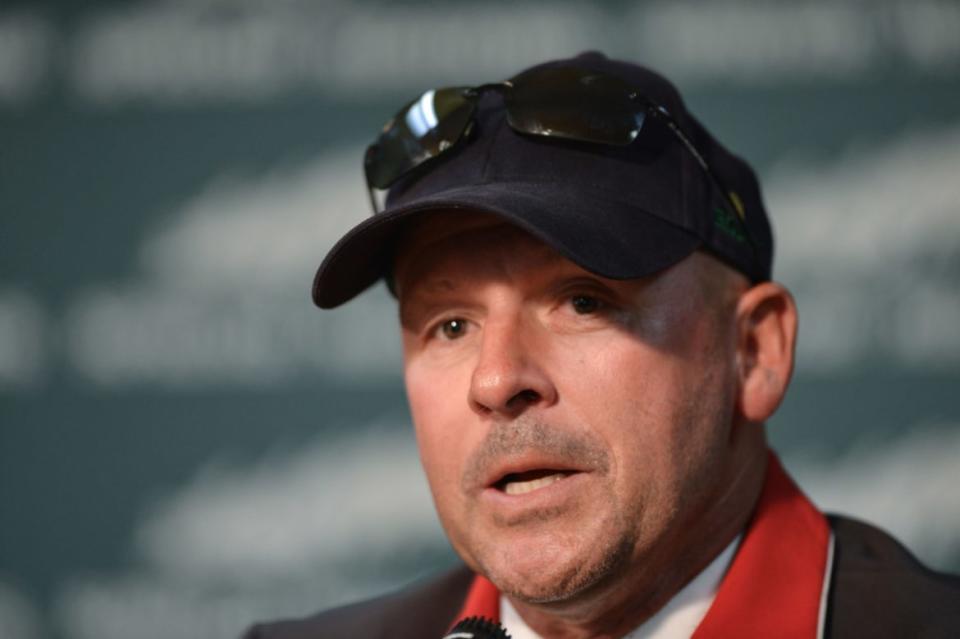
Eric Lamaze at a post-competition press conference
Four years later, Lamaze qualified for the Olympic Games again, only to fail the drug test a second time. “I got fucked,” he now fumes. “They fucked me big time.” In this instance, coke wasn’t the culprit. Lamaze cited cold medication.
“It was quite tragic in the sense that… he was really committed to turning things around,” says Lamaze’s friend and lawyer Tim Danson, who recently asked to be removed as his attorney.
Lamaze had tested positive for pseudoephedrine and ephedrine, a Canadian magazine reported at the time. He blamed the former violation on the cold medicine; the latter, he said, happened because the manufacturer of his diet pills had quietly changed the formulation. Despite his excuses, he received a lifetime ban.
Lamaze spiraled. “I had nothing left,” he says. “I went partying with some friends and did some drugs… My life was over.”
But it wasn’t. Thanks to Danson’s lawyering, Lamaze won a reversal on the drug violation—though it proved another short-lived win. He was quickly drug tested again and flagged for cocaine. The lifetime ban was reimposed.
Remarkably, Danson managed to wriggle Lamaze out of it once more, arguing in an appeal that his drug bender had been precipitated by the original, overturned ban. Lamaze, through a legal miracle, got his life back—though he didn’t compete at the 2000 Olympics.
Comeback Kid
Eight years later, after missing out on the Athens Games, Lamaze finally earned a shot at Olympic redemption in Beijing. Riding Hickstead, a celebrated Dutch Warmblood stallion, he advanced to a jump-off in the individual event. His opponent, Rolf-Göran Bengtsson of Sweden, nicked a rail in the final round. With a clean run, Lamaze would secure individual gold, making him the first Canadian show jumper to do so.
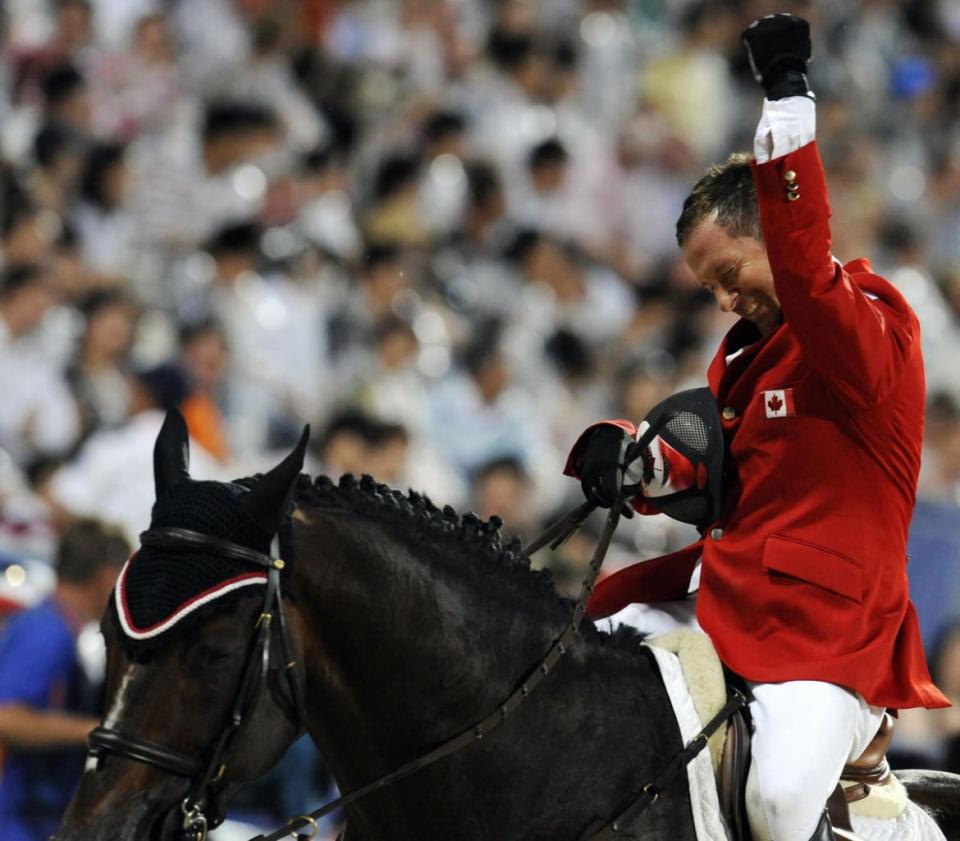
Eric Lamaze, riding Hickstead, celebrates after winning gold in the 2008 Olympic Games.
Hickstead sailed over the final wall, and Lamaze threw his helmet skyward, beaming. “I was just so in the zone… That was the best riding I ever did in my life,” he says. “It’s hard to put me in the zone. I’ve won a lot of Grands Prix not in the zone at all.”
Afterwards, he says, he nearly wanted to stop riding: “You want to stay on the high of the Olympics, because you know you’re going to fall off soon.”
In his case, the decline wasn’t instant. In 2010, Hickstead was named “best horse” at the World Equestrian Games, and Lamaze won yet another Grand Prix, the highest tier of show jumping competition.
Then, abruptly, came the fall. In 2011, in Verona, Italy, Hickstead completed a 72-second ride, then keeled over, his legs flailing sideways. Lamaze removed his gloves and looked on helplessly. The horse was reported dead of an aortic rupture.
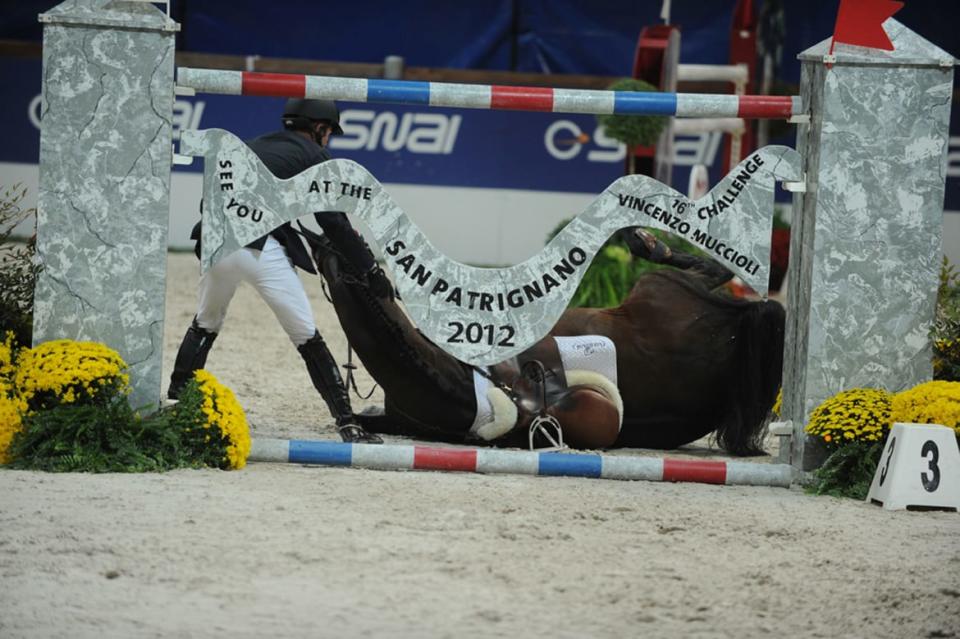
Hickstead, ridden by Eric Lamaze, after a fatal fall during Jumping Verona 2011.
Lamaze remembers nothing of those moments. “I think I got on the plane. I took, like, four vodkas straight, like, bang,” he says.
Back at his stable, Torrey Pines, he grew detached. “You could see he was really depressed, and for a couple months he lost his interest in horses,” says a person who worked for him at the time.
Lamaze opted for more self-medication: “That’s when I had a really bad drinking problem,” he says. “Every horse you ride after that, you think they’re gonna die.”
Questions Pile Up
Sympathy for Lamaze poured in, but by then opinions of the Olympic champ had begun to diverge.
He was beyond rich, thanks to his horse sales and a constant flow of real estate deals in Florida. Often, he opted for private planes and helicopters.
Some people close to Lamaze found him generous and warm. Cathy Inch, the Ontario riding coach, says he would invite her to Wellington, Florida, for a month at a time after her husband died. “Eric was always very good to me,” she says.
Angel Karolyi, a former close friend, considers Lamaze “an unbelievable athlete and leader in the sport.”
Lamaze’s detractors, however, questioned his methods for amassing so much wealth. “He’d have new clients, [and] people would leave pissed,” recalls one of his students. “At first you think, ‘Oh, well, the daughter was difficult. She didn’t want to listen… And then it was like, ‘Okay, now it’s happened to another person and another person.’”
In 2010, a stable called Iron Horse Farm sued Lamaze and Torrey Pines for roughly $800,000 in damages, claiming he had misrepresented three horses he sold to the father of a young rider named Karina Aziz. (Industry outlets like Horse Sport and The Chronicle of the Horse have previously reported on the litigation.)
Aziz, now 36, says Lamaze made a habit of duping buyers. “They were sold these faulty horses. And then Eric would say, ‘Oh, you’re a terrible rider, it’s not the horse, like, I’m Olympic champion.’” Some of the buyers were not “super rich,” she adds, preempting any impulse for schadenfreude against millionaires.
In Aziz’s case, the most egregious alleged misrepresentation was with a horse named Peppercorn, which went lame less than a year after the $265,000 transaction, the lawsuit says. The complaint accuses Lamaze of concealing the horse’s true “identity, age, show record, physical condition and capabilities.”
After filing her lawsuit, Aziz says, she was told to investigate whether Peppercorn had undergone a “neurectomy,” a surgery that results in a horse losing feeling in its foot—thereby making it dangerous and unfit for show jumping.
She and her team shaved Peppercorn’s front legs and, “sure enough,” they found scars. A veterinary report prepared for Aziz says the marks are “strongly suspicious for surgical neurectomy.”
Lamaze denies wrongdoing, and he firmly disputes that he would sell a de-nerved horse, telling The Daily Beast “it bothers the shit out of me” when deals don’t work out. He says he has usually tried to resolve issues with disgruntled buyers.
Philosophically, though, he says the claims aren’t his problem. “It’s your job to check what you’re buying, not mine,” he says. “In our business, [it’s] rich daddy, princess girl. They want what they can’t ride.”
Yet even some of Lamaze’s defenders say the claims against him are very serious and unusual. “Personally, I’ve never been harmed by him,” says Inch, who emphasizes that she doesn’t know if the accusations against him are true. “But when I hear these stories, it’s pretty atrocious.”
Since the Aziz lawsuit, Lamaze has been embroiled in other disputes—with his personal assistant, his condo owner, horse buyers, business partners, his credit card company, his former law firm, and, reportedly, a bank that gave him money for a yacht.
“Eric is like a cat with nine lives. And I feel like he finally pushed his luck a little too far,” one of his old students says.
Unexplainable Miracles
In 2017, Lamaze told members of his inner circle that he had been diagnosed with brain cancer. He seemed visibly weak, recalls Madison McLarren, who joined Torrey Pines just before the announcement.
“He would start riding and not be able to finish,” she says. On certain days, Lamaze wouldn’t show up at all. “Everyone kind of saw his health deteriorate. So again, it’s hard to say… I don’t want to believe that that was all an act.” McLarren says she liked Lamaze and did not see him use drugs.
Lamaze’s mother also maintains that the cancer diagnosis was real, as does his ex-wife. “He’s very social, and during that time he was not able to stay up past 5:30, six at night,” Johnstone, his ex-wife, says. “So it would be very out of character. I think someone who was on drugs would be go go go.”
Still, Lamaze continued to ride competitively. At some events, he seemed foggy and unwell. Yet in 2018, he managed to win a $292,000 Grand Prix in Calgary.
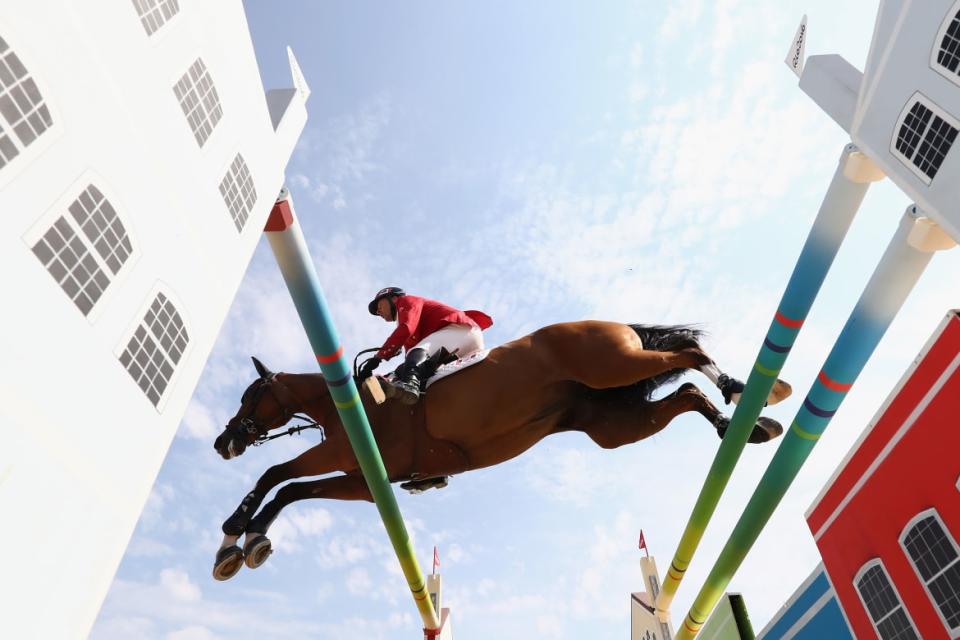
Eric Lamaze rides Fine Lady 5 during Team Jumping on Day 11 of the Rio 2016 Olympic Games.
The next year, Lamaze publicly broadcast his cancer diagnosis and requested the postponement of a deposition in the Aziz case. The plaintiffs’ lawyers grew skeptical, however, after learning that he was still competing.
According to Jerome Morse, one of Aziz’s attorneys, Danson represented to the court that Lamaze was deathly ill. “You know, January 19, 20, he’s on his deathbed for brain cancer. And on January 31, he’s jumping in Wellington,” Morse recalls. “We put an investigator on him in Wellington. And sure enough, throughout March he competed, and competed rather well.”
Lamaze eventually sat for the deposition, though he stood by his health claims. In a 2020 interview, he asserted that the cancer treatment had decimated his organs. His kidney got seriously infected, putting him at risk of a heart attack or stroke, he said, adding that his doctors considered a transplant but didn’t feel he would survive the operation. Instead, he purportedly received an unapproved alternative, an artificial kidney controlled by a computer chip.
“I kind of immediately started to feel better, to be honest. My body just started to clean itself a little bit,” he told the interviewer.
This kind of implant would have placed Lamaze at the vanguard of medical technology. Pressed for more details, he tells The Daily Beast he worked with a doctor in either Australia or New Zealand, though he declines to name them. As for procuring the organ, he says, “They have access to things on the internet that nobody else has access to… Depending how many people need it, it’s a bidding war.”
“I do not believe that is possible,” F. Perry Wilson, an associate professor at the Yale School of Medicine specializing in nephrology, says of this kind of arrangement. Researchers are working to develop artificial kidneys, he says, but they are “still VERY much in the prototype stage.”
Jonathan Himmelfarb, professor of medicine at the University of Washington and founding director of the Kidney Research Institute, echoes that sentiment, “I suppose that the technology could exist (never say never) but I am unaware of its existence.”
It seems likely that Lamaze has experienced some health issues, though it is not clear what was treated. He sent The Daily Beast an undated photo of himself in a hospital bed, and a close-up image of a shaved head with a jagged scar on the side, saying it was from one of his brain cancer surgeries.
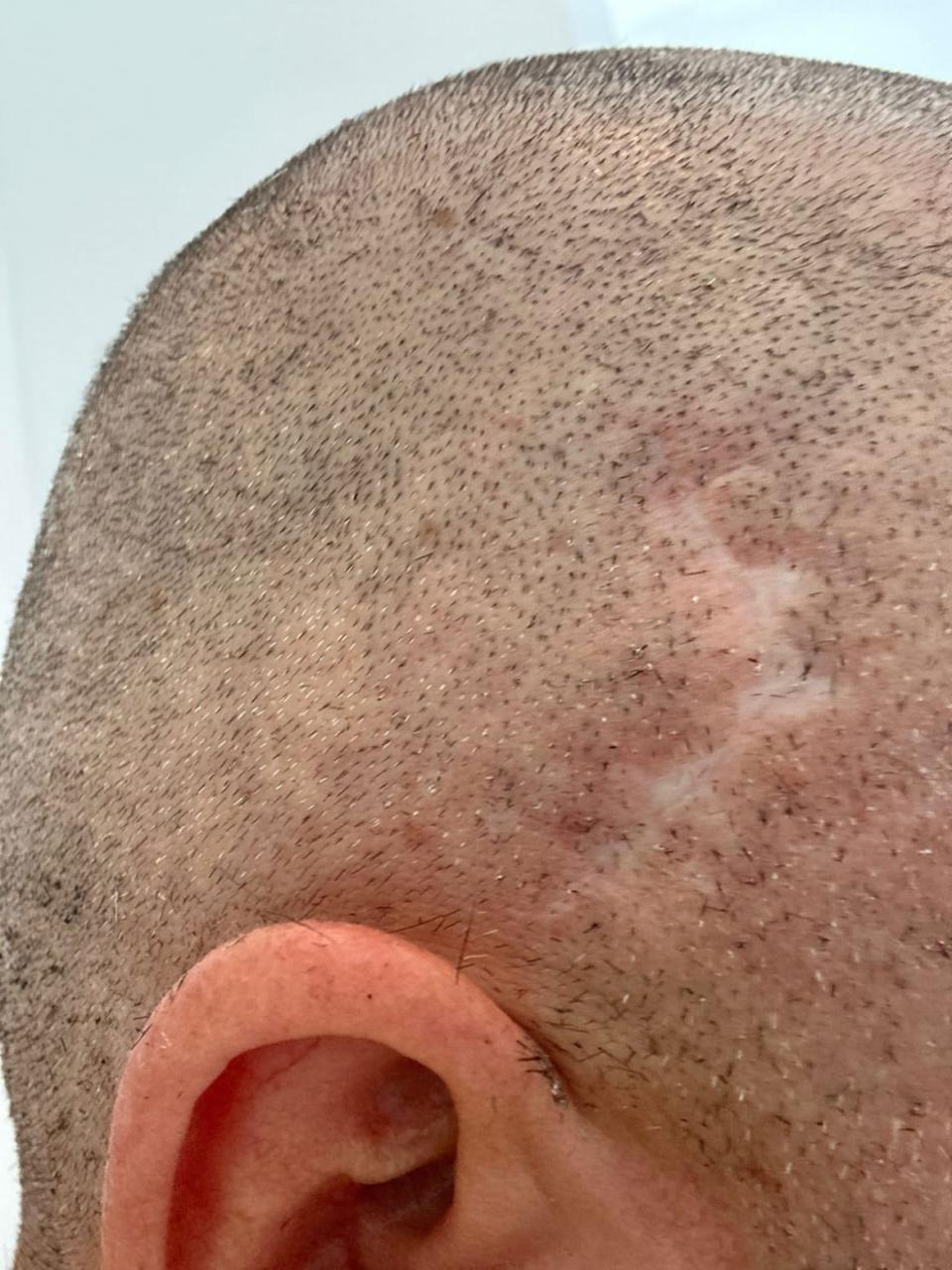
A jagged scar that Eric Lamaze says is from one of his brain cancer surgeries.
A neuro-oncologist who reviewed the image says that those operations tend to leave more “linear” scars, though it is “theoretically possible” that the healed wound was caused by a tumor surgery.
That said, the physician continues, “If a person were to fall and open up the head a little bit with a laceration, and then that gets sutured, it could also look like that.”
Failure to Submit
The hushed whispers about Lamaze grew louder in 2021 when, during a competition in Valkenswaard, the Netherlands, he was selected for random drug testing and refused to comply.
Lamaze claims the testing official wasn’t wearing identification and didn’t have the proper paperwork. When the official persisted, Lamaze says, he grew alarmed: “I felt like I was getting kidnapped, honestly.”
Show jumping’s governing body, the International Federation for Equestrian Sports—known as FEI—opted not to crack down aggressively on Lamaze, since he argued his illness would force him to retire anyway, Danson says. (The FEI declined to comment on specifics, since proceedings are underway at the Court of Arbitration for Sport over Lamaze’s failure to submit the testing sample. The FEI reportedly is now also pursuing a tampering charge against Lamaze, claiming fake medical documents were submitted in those proceedings as well.)
Subsequently, and despite the drug-testing dispute, Equestrian Canada named Lamaze to a top show jumping role, a position known as chef d’équipe. It was a massive honor, but Lamaze says he hated the job. “You cannot go [from] Wayne Gretzky to coaching a team,” he says. “Traveling the world without your riding jacket is the saddest thing that can happen to riders.”
Reached for comment, Equestrian Canada says it had received “multiple assurances” from Lamaze and Danson that he was eligible for the role, and that the organization only later learned of his “paused” dispute with the FEI.
Danson insists he was fully transparent.
Sticking to His Story
Around the start of this year, Lamaze’s professional life was again in peril. A deal to buy and train horses for two wealthy equestrians—Tara Rein and her billionaire husband, Mark, who co-founded Fortnite maker Epic Games—fell apart. A source familiar with the situation says Lamaze stopped showing up for work and wasn’t paying his staff: “He just didn’t give a shit.”
“I think he had the right to do what he did. I would have done the same thing,” Lamaze concedes, referring to Rein. “I don’t blame them for anything. I blame myself.” (Rein declined to comment.)
This summer, as his litigation in Canada was heating up, Lamaze’s face appeared seriously damaged. There was a large cavity near his nose and mouth, generating speculation about the source of his health problems, including whether he had relapsed. Lamaze maintained he was still suffering from cancer.
After reviewing images of Lamaze, Robert Kotler, a plastic surgeon in Beverly Hills, told The Daily Beast his condition seemed like the result of an external injury, perhaps a major infection or tumor, though he couldn’t say for sure. Another plastic surgeon, Jay Calvert, had a different take, with the same caveat about certainty: “It’s fair to say that something’s going on with his nose and maxilla that would be consistent with cocaine use. There’s very few things that do this.”
According to Danson, Lamaze believed his facial injuries would be sufficient to delay the trial. When that proved untrue, Danson says, he pushed for more documentation. Once he received them, Danson says he took the documents at face value. “It would be unthinkable to think that these were anything but truthful and authentic.” And yet, they were fakes.
Lamaze has yet to explain the discrepancy beyond casting blame on his staff and on Danson, suggesting there was a conspiracy to ruin him. On Sept. 9, he also posted a 2,000-word screed to his personal Facebook page—which he later deleted—in an attempt to offer a portion of his story. The note was meandering and frequently unintelligible, stirring speculation about Lamaze’s mental state. (Danson says Lamaze may be using Siri for dictation, and English isn’t his first language.) He sent similarly inscrutable text messages to The Daily Beast but seemed far more cogent on the phone.
Lamaze is emphatic that he isn’t using drugs, nor can he afford to, he says. Though he has recently done more than seven figures in horse deals, his accounts have been garnished, thanks to litigation in Florida. (His lawyer on that case withdrew, too, due to “irreconcilable differences.”) “Ask me to go buy a hamburger today, I can’t,” Lamaze claims.
The full truth about the last six years will likely need to come from Lamaze, and so far, his story isn’t shifting. In his telling, he is in the final chapter of a simple tale: an icon hastily betrayed by the community he once saw as his adoptive family. “I’m at the end of having fought and fought for people I actually wanted to see one more time that today no longer [speak] to me,” he says. “I’m not guilty. I mean, bring it on.”
Get the Daily Beast's biggest scoops and scandals delivered right to your inbox. Sign up now.
Stay informed and gain unlimited access to the Daily Beast's unmatched reporting. Subscribe now.

